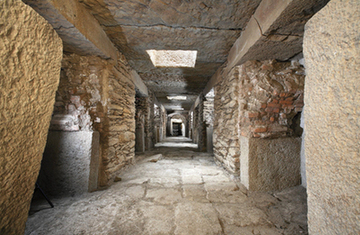
Above: Child holding a model of the Aksum Obelisk by Hiwot
Gebre Geziabeher (9 years old) for UNESCO
Monday, April 20, 2009
An exhibition – photographs and a video installation – at UNESCO will celebrate the reinstallation of the Aksum obelisk. The show will give visitors a chance to learn about the history of the Ethiopian site and to view the key stages of reinstalling the monument, 24 metres high and weighing 150 tons.
Open to the public from 4 to 15 May (9 a.m. to 5.30 p.m.), the exhibition will be inaugurated on 23 April by Koïchiro Matsuura, the Director-General of UNESCO, in the presence of the Ethiopian and Italian ambassadors to UNESCO, Adelech Haile Mikael and Giuseppe Moscato.
The artists in the show, who are from Ethiopia, Belgium, France and Italy, were invited by UNESCO to visit Aksum and to express their vision of the restoration of the obelisk, a symbol of Ethiopian culture.
Their works highlight the uniqueness and magnitude of the project. The monument’s history has been eventful: erected in the 4th century then vandalized in the 7th, the obelisk was hauled off to Rome at Mussolini’s orders and set up near the Circus Maximus, finally returning to Aksum in 2005.
The artists – Tito Dupret, Theo Eshetu, Hiwot Gebre Geziabeher, Michael Tsegaye and Paola Viesi – give their personal interpretations of these events. The gigantic, 15-screen video installation by Theo Eshetu benefits from the dual perspective of the artist, born in Ethiopia and living in Rome. Hiwot Gebre Geziabeher, a schoolgirl from Aksum who learned photography from Michael Tsegaye, takes the local inhabitants’ point of view. Included in the show are films and photos depicting the extraordinary reinstallation work and Aksum’s lifestyle and culture. For an even better sense of the project’s scope, a 360°* projection offers visitors a simulated tour of the Aksum archaeological site and works.
With this exhibition, UNESCO is celebrating the successful reinstallation and showing how a cultural project can help bring about reconciliation between two countries with conflict in their past.
This project and this exhibition were made possible thanks to the generous contribution of the Italian Government.
From 4 to 15 May, individuals and school groups may reserve guided visits organized by UNESCO, Monday to Friday, 9 a.m. to 5.30 p.m.
Contact for inauguration accreditation:
Djibril Kébé, tel. + 33 (0)1 45 68 17 41 / d.kebe@unesco.org
*Website with 360° images : http://www.1001merveilles.org/15
Related: Royal Monuments Recall the Lost Glory of an African Empire

Source: Archaeology:
A publication of the Archaeological Institute of America
Of Obelisks and Empire
By Mark Rose
Photographs by Chester Higgins, Jr.
Royal monuments and ancient accounts recall the lost
glory of an African kingdom
In the first century A.D., an unknown merchant recorded details of the Red Sea trade, and mentioned Adulis, the harbor of “the city of the people called Aksumites” to which “all the ivory is brought from the country beyond the Nile.” The ruler of Aksum, he wrote, was Zoskales, who was “miserly in his ways and always striving for more, but otherwise upright, and acquainted with Greek literature.” Just two centuries later, the philosopher Mani (ca. A.D. 210-276) included Aksum as one of the four great empires, along with Rome, Persia, and Sileos (possibly China). And in 274, envoys from Aksum took part in the triumphal procession staged by the emperor Aurelian when he paraded the captured Queen Zenobia of Palmyra, fettered with gold chains, through Rome.
Today, Aksum is a dusty, regional market town of about 50,000 in northern Ethiopia. If people have heard of it, perhaps it is on account of another queen: the Biblical Sheba. According to the Kebra Nagast (Book of the Glory of the Kings), an early-14th-century compilation that chronicles Ethiopia’s rulers, Solomon and Sheba had a son, Menelik, who brought the Ark of the Covenant from Jerusalem to Aksum. The Ethiopian Orthodox Church maintains that the Ark is still kept within the precinct walls of the Church of Tsion (Mary of Zion) in Aksum. Read more.


























Interesting, on my last visit to Axum I had a wonderful experience and lots of work has been done by UNESCO in Gonder area, especially the repair of the roofs on churches.
It is great to bring out forgotten,neglected or even dead historical facts into existance.This will help the country and its people in many ways. If we had time ,knowledge and the most important of all PEACE ,we could have done it a long time ago.It is good to see an organization like UNESCO does for the benifts of all humanbeing experiences.